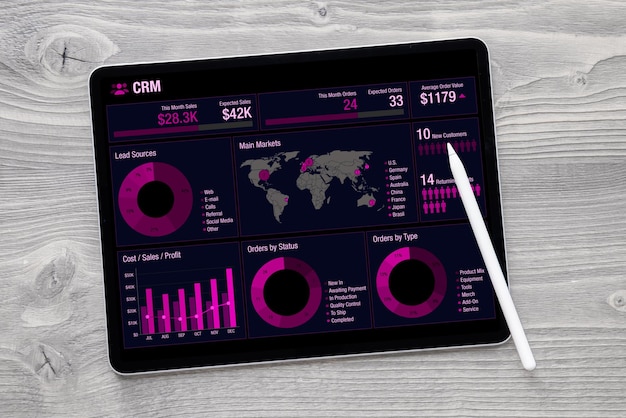Set & Achieve Financial Health Goals in 6 Months

Setting realistic financial health goals and achieving them in six months involves assessing your current financial situation, defining specific and measurable objectives, creating a detailed plan, tracking progress regularly, adjusting strategies as needed, and staying disciplined.
Taking control of your financial future doesn’t have to feel overwhelming. This guide breaks down how to set realistic financial health goals and achieve them in six months, providing actionable steps to improve your financial well-being.
Understand Your Current Financial Situation
Before setting any goals, it’s critical to understand where you currently stand. This involves taking a close look at your income, expenses, assets, and liabilities. Knowing your starting point is the first step towards creating a realistic and achievable plan.
Assess Your Income and Expenses
Start by calculating your monthly income. Include all sources, such as salary, investments, and any side hustles. Next, track your expenses. You can use budgeting apps, spreadsheets, or even a simple notebook to record where your money is going.
Calculate Your Net Worth
Your net worth is the difference between your assets (what you own) and your liabilities (what you owe). Assets include cash, investments, and property. Liabilities include debts such as loans, credit card balances, and mortgages. Calculating your net worth provides a snapshot of your overall financial health.
- List all your assets: Include cash, savings, investments, and valuable possessions.
- List all your liabilities: Include debts like credit card balances, loans, and mortgages.
- Subtract liabilities from assets: The result is your net worth.
Understanding your current financial situation is crucial for setting realistic goals and tracking your progress. It’s the foundation upon which you’ll build your financial health plan.

Define Specific and Measurable Financial Goals
Once you have a clear understanding of your current financial situation, it’s time to define your goals. The key to setting achievable goals is to make them specific, measurable, achievable, relevant, and time-bound (SMART).
Create SMART Goals
SMART goals provide a framework for setting objectives that are clear and attainable. A specific goal is well-defined, a measurable goal can be tracked, an achievable goal is realistic, a relevant goal aligns with your values, and a time-bound goal has a deadline.
Examples of Realistic Financial Goals
Here are some examples of financial goals you might set for yourself within the next six months, categorized by common financial needs:
- Emergency Fund: Save $1,000 in an emergency fund to cover unexpected expenses.
- Debt Reduction: Pay off $500 in credit card debt by reducing discretionary spending.
- Savings: Increase monthly savings by 10% to build a financial cushion.
Setting SMART goals is essential for staying motivated and tracking your progress. By defining what you want to achieve, you’re more likely to stay focused and make informed financial decisions.
Develop a Detailed Financial Plan
With your goals defined, the next step is to create a detailed plan for how you’ll achieve them. This plan should outline the specific actions you’ll take, the resources you’ll need, and the timeline you’ll follow.
Create a Budget
A budget is a roadmap for your money. It shows you where your money is coming from and where it’s going. Start by listing your income and expenses. Then, allocate your money to different categories, such as housing, food, transportation, and entertainment. Identify areas where you can cut back to free up money for your goals.
Automate Savings
One of the most effective ways to save money is to automate the process. Set up automatic transfers from your checking account to your savings account each month. This ensures that you’re consistently saving money without having to think about it.
- Set up automatic transfers: Schedule regular transfers from your checking account to your savings account.
- Choose the right savings vehicle: Consider high-yield savings accounts or money market accounts for better returns.
- Start small and increase over time: Begin with a manageable amount and gradually increase your savings rate.
A well-crafted financial plan is your guide to achieving your goals. It provides structure, direction, and accountability, helping you stay on track and make progress.
Track Your Progress Regularly
Tracking your progress is essential for staying motivated and making adjustments to your plan as needed. By monitoring your income, expenses, and savings, you can see how far you’ve come and identify areas where you need to improve.
Monitor Your Spending
Keep a close eye on your spending to ensure you’re staying within your budget. Review your bank statements and credit card statements regularly to identify any unnecessary expenses. Use budgeting apps or spreadsheets to track your spending in real-time.
Review Your Goals
Regularly review your financial goals to assess your progress. Are you on track to meet your targets? If not, what adjustments do you need to make? Make sure your goals are still relevant and achievable. Adjust them if necessary to better align with your current situation.
Tracking your progress is a vital part of achieving your financial goals. It provides valuable insights into your spending habits and helps you stay accountable to your plan.
Adjust Your Strategies as Needed
Life is unpredictable, and your financial situation may change over time. Be prepared to adjust your strategies as needed to stay on track with your goals. This might involve cutting back on expenses, finding new sources of income, or modifying your savings plan.
Be Flexible
Don’t be afraid to adapt your plan to changes in your circumstances. If you experience a job loss or unexpected expense, adjust your budget accordingly. Look for ways to reduce spending or increase income to compensate for the setback.
Seek Professional Advice
If you’re struggling to achieve your financial goals, consider seeking professional advice from a financial advisor. A financial advisor can help you create a personalized plan, offer guidance on investment strategies, and provide support to help you stay on track.

Adapting your strategies to changing circumstances is essential for long-term financial success. By staying flexible and seeking professional advice when needed, you can overcome challenges and achieve your goals.
Stay Disciplined and Consistent
Achieving your financial goals requires discipline and consistency. Stay committed to your plan, even when it’s challenging. Avoid impulsive purchases, stick to your budget, and continue to track your progress. Small consistent actions over time will lead to significant results.
Practice Patience
Building financial health takes time and effort. Don’t get discouraged if you don’t see results immediately. Be patient, stay focused, and trust the process. Consistent effort will eventually lead to success.
Reward Yourself
Celebrate your milestones along the way to stay motivated. When you reach a goal, reward yourself with something small that won’t derail your progress. This could be a special treat, a fun outing, or a small purchase. Recognizing your accomplishments will help you stay committed to your plan.
Staying disciplined and consistent is the key to achieving your financial goals. By committing to your plan and practicing patience, you can build a secure and prosperous financial future.
| Key Point | Brief Description |
|---|---|
| 📊 Assess Finances | Understand your income, expenses, assets, and liabilities. |
| 🎯 Set SMART Goals | Define specific, measurable, achievable, relevant, and time-bound targets. |
| ✍️ Create a Plan | Develop a budget and automate savings to ensure progress. |
| 🔄 Track & Adjust | Monitor progress and adapt strategies for continuous improvement. |
Frequently Asked Questions (FAQ)
▼
A realistic initial emergency fund goal is $1,000. This provides a buffer for unexpected expenses like car repairs or medical bills. Aim to increase it to 3-6 months’ worth of living expenses over time.
▼
Use budgeting apps, spreadsheets, or a notebook to record your spending. Categorize expenses to identify areas for potential cuts. Review bank and credit card statements regularly to monitor your financial activities.
▼
Automate savings by setting up recurring transfers to a savings account. Cut back on discretionary spending like dining out or entertainment. Look for discounts and coupons when shopping to reduce expenses.
▼
Consider seeking professional financial advice if you’re struggling to achieve your goals or need help with complex financial decisions. A financial advisor can provide personalized guidance and support.
▼
Regularly reviewing your financial goals is crucial. Assess your progress, adjust strategies as needed, and ensure your goals remain relevant. This helps you stay on track and adapt to changing circumstances.
Conclusion
Setting and achieving realistic financial health goals in six months is entirely possible with the right approach. By understanding your current financial situation, defining specific goals, creating a detailed plan, tracking your progress, adjusting your strategies, and staying disciplined, you can take control of your financial future and build a more secure and prosperous life.






